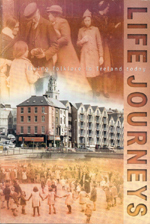Nick Hennessy: Racism, Adoption, Childhood
Title
Subject
Description
He was adopted and lived in Dublin and then in County Kerry. As a child, the family had a pet crow and a pet fox. His father was a construction engineer. In Listowel, he was taught by writer Bryan MacMahon and learnt to speak Irish.
He talks about the difficulties of being mixed race in Ireland.
He spent time in London and set up a co-operative organisation to provide housing.
Date
Identifier
Coverage
Relation
Hunter, Stephen (1999), Life Journeys: Living Folklore in Ireland Today, Cork: The Northside Folklore Project.
Source
Rights
Language
Type
Format
Interviewee
Interviewer
Duration
Location
Original Format
Transcription
S.H: Yeah, can you mm tell me something about the games you played as a child?
N.H: Well when we moved to Listowel in 1967 I think it was mm we were notorious we were the wild Hennessey bunch that blew into town one day and caused a storm until the day we left, what we used to get up to was ah there was a castle in the square in Listowel, and we used to climb that, get up to the top of it, and there was a gooseberry tree on the top of it and used to eat the gooseberries off it you know. We used to ride horses, we used to ah play games with this goat we had. You’d put down your head forward, and the goat would put down its head forward and run at you, you know, and you’d grab it by the horns and push and it would push you know? We’d ah … we used to… cowboys and Indians and all those things you know that children did back in those days you know.
S.H: Can you remember any older sort of traditional childhood sort of games like ah .. variants of ‘four square’ or skipping ‘hopscotch’ boys don’t usually skip but ‘hopscotch’ or marbles or?
N.H: Yeah, marbles conkers, ah the spinning top a piece of wood shaped sort of like a cone, and you have a piece of stick with its ring off it and you whip it and it spins, spinning top you know. And yoyos’ we had, but one of my earliest memories would have been in mm in Longford or Laisebrooke?? in the square in Laisebrooke playing conkers during the school break you know.
S.H: Yeah.
N.H: There was a lot of conker trees around the area you know, but ah .. yeah we had a lot of creatures as pets when we were growing up you know, we’d tortoises we’d hedgehogs, we’d foxes, we’d a hawk we’d ah…
S.H: How did you come to have a hawk?
N.H: We found - It fell out of a nest, and we had a crow as well.
S.H: Gee, at the same time?
N.H: Different periods.
S.H: What sort of hawk was it do you know?
N.H: Just an ordinary hawk.
S.H: Yeah.
N.H: I think we
S.H: Was it friendly or?
N.H: We used to feed it you know. I think we let it go, let it into the wilds. But we had a crow, Jacko was its name, and mm it would squawk every time it was hungry and it would be in the garage you know, and we’d go out and feed it bread and milk you know, but ah Jacko – I mean, he used to sit on my mother’s shoulder while she was reading a book you know, and he would try and read, try and communicate with us you know. Or when we had the foxes we used to play with the foxes.
S.H: How did you come to have foxes?
N.H: Ah my father brought them home one day from Tarbert, when Tarbert Power Station was being built you know, and ah he brought it home, thought that we might like it and its name was Rooey it was a vixen.
S.H: What was its name?
N.H: Rooey.
S.H: Rooey, yeah.
N.H: It means red one, red one and mm Rooey, we used to play with it and, it used to eat liver that is all it would do. We eventually gave it to Eamonn De Butleir who had a wild sanctuary up in Dublin somewhere – up in Wicklow. He came down from Wicklow one afternoon while we were at school, but he waited until we came home from school and then he took the fox and let it free in his reserve you know.
S.H: Obviously, he thought it was nice to tell you kids it was going, he didn’t just want to take it.
N.H: We had got a dog then you see, we fell in love with this pup called Sancha, and ah my mother rather than put the fox down we decided to give it to Eamonn De Butleir and let him look after it you know.
S.H: Would the dog and fox not have been able to co-exist?
N.H: Not really I wouldn’t have thought so because the fox would have been frightened of the dog you know, even though the dog would have been a pup you know.
S.H: Yeah.
N.H: They wouldn’t have really got on because the dog would have got older much quicker, and its instinct for a dog to hunt foxes anyway you know.

